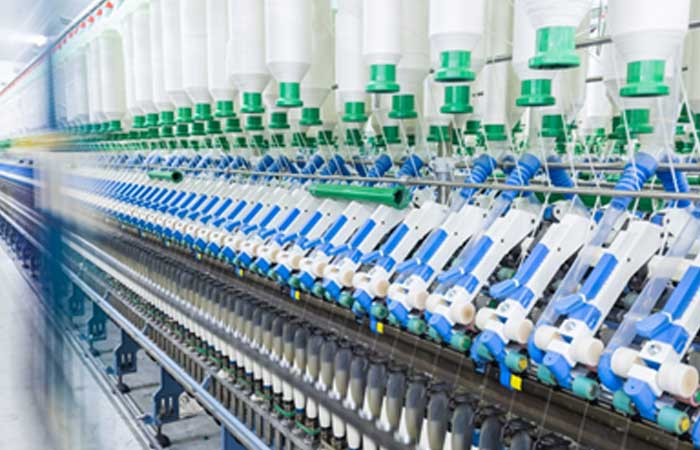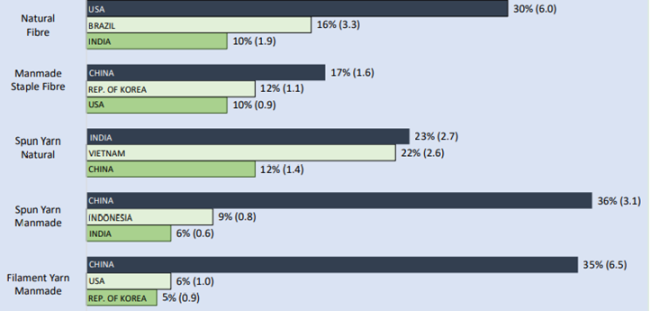
MMF: Spinning a success tale
As the demand for synthetic fibres continues to rise, Divya Shetty examines how spinning units are leveraging this trend through constant innovation.
The spinning of synthetic fibres, notably Man-Made Fibres (MMF), is experiencing a surge in the modern textile landscape. The mills are now increasingly utilising man-made fibres to maintain stable fabric costs amidst rising cotton prices. MMFs, such as polyester, nylon, and acrylic, offer a plethora of advantages over traditional natural fibres like cotton or wool.
According to Invest India, man-made fibre production in the period from April 2021 to January 2022 was recorded at 1,803 kg. During the same period, man-made filament yarn production was 1,676 kg, and total spun yarn production reached 4,872 kg. The domestic MMF industry primarily consists of two components: polyester and viscose. Polyester constitutes approximately 77.5 per cent, while viscose makes up the remaining portion.
MMF is mainly utilised in the production of 100 per cent non-cotton fabrics and blended fabrics, which are subsequently used in ready-made garments, home textiles, and various industrial textiles.
The combination of cost-effectiveness, durability, versatility, and technological advancements makes synthetic fibres a preferred choice for various segments of the textile industry
–Rajeev Tulshyan, Director, Kennigton Group
The driving force behind this growing demand is the rising and volatile price of cotton. Additionally, since cotton is one of the most water-intensive crops, manufacturers are gradually shifting their preference to synthetic fibres. Rajeev Tulshyan, Director, Kennigton Group, says, “Synthetic fibres offer a wide range of properties and characteristics that can be tailored to specific needs. This versatility allows manufacturers to produce fabrics suitable for various applications. The spinning of synthetic fibres offers numerous benefits that cater to the evolving needs of the textile industry, driving their increasing adoption and usage in various sectors.”
Our goal is to prevent high-performance fibres from being relegated to low-cost applications and instead recycle them for high value uses.
–Dr Nandan Kumar, Managing Director, High Performance Textile
The days when a manufacturer could profit by using just one type of fibre are over. Now, manufacturers need to incorporate various fibres, a practice known as blending. Dr Nandan Kumar, Managing Director, High Performance Textiles,opines, “Today, it is essential to innovate by incorporating percentages of fibres like nylon or other synthetics to create yarns that meet specific technical qualifications. Examples include Modacrylic-cotton blends, cotton-aramid blends, and cotton-nylon-aramid blends. Currently, there are more than 50 such combinations being used globally, where blends involve up to 30-40 per cent natural fibres like cotton or wool, with the remaining being synthetic fibres.” Hence the demand for synthetic fibre has shot up.
The catalyst
As the demand for technical textiles continues to surge across all sectors, there’s been a corresponding spike in the demand for MMFs. This is because MMFs are well-suited for technical textiles. “The spinning industry is an upcoming segment for the development of novelty filament yarns for advance applications in textiles, such as in technical Textiles; so it is having a high prospects to meet all the need of technical textile segment,” states Pankaj Gandhi, Director, The Man-Made Textiles Research Association (MANTRA).
“The rising demand for performance-driven textiles in various sectors such as active wear, technical textiles, and automotive textiles has propelled the adoption of synthetic fibres. These industries require materials that offer enhanced functionality, such as moisture management, UV protection, and abrasion resistance, all of which are inherent characteristics of many MMFs,” asserts B Sankar, G M of Technical and Development, Perfect Engineering Corporation.
Apart from performance textiles, one of the primary segments driving the consumption of MMFs is apparels covering casual wear, sportswear, and outerwear. Their performance attributes, including moisture-wicking capabilities, durability, and stretchiness, are indispensable for crafting activewear and athleisure garments.
The sector is going to utilise, Industry 4.0, IoT and AI in synthetic fabrics, AI will be used in digital printing IoT will be a game changer in smart textiles and in medical textiles.
–Pankaj Gandhi, Director, The Man-Made Textiles Research Association (MANTRA).
Another vital domain benefiting from synthetic yarns is the home textiles market, which encompasses bedding, upholstery, and curtains. Synthetic fibres excel in resisting fading, staining, and wrinkling, making them ideal for applications where durability and easy maintenance are essential.
Additionally, the automotive textiles industry heavily relies on synthetic yarns. Their ability to endure harsh environmental conditions and frequent usage is invaluable. From seat covers to carpets, synthetic fibres enhance the longevity and performance of various automotive interior components.
Synthetic fibre manufacturers are collaborating with partners across the value chain, including brands, retailers, and recycling facilities, to establish closed-loop systems that facilitate the collection, sorting, and recycling of textile waste.
–B Sankar, G M of Technical and Development, Perfect Engineering Corporation
Besides all this, MMF has become a preferred choice for manufacturers due to its cost-effectiveness and durability. MMFs can be produced at a lower cost than many natural fibres, making them an appealing option for businesses aiming to optimise their production processes without sacrificing quality. Furthermore, the consistent quality and availability of MMFs increase their attractiveness to textile manufacturers, ensuring dependable sourcing and production schedules. They exhibit remarkable versatility, featuring attributes such as resilience, moisture-wicking capabilities, and resilience against wrinkles and shrinking, rendering them suitable for various uses. Furthermore, MMFs can be tailored to emulate the appearance and texture of natural fibres, granting designers and producers extensive creative latitude. “The combination of cost-effectiveness, durability, versatility, and technological advancements makes synthetic fibres a preferred choice for various segments of the textile industry,” adds Tulshyan.
Recycling of MMF
The growing focus on sustainability and environmental friendliness within the textile sector has spurred manufacturers to explore alternative materials like recycled synthetic yarns. Through the integration of recycled polyester or nylon fibres into their offerings, companies can diminish their ecological impact while satisfying consumer preferences for sustainable textiles.
Advanced recycling methods empower synthetic fibre producers to recover and treat materials like discarded polyester apparel, plastic bottles, and industrial refuse, converting them into premium recycled yarns. These upcycled yarns deliver identical performance attributes as virgin fibres but with markedly decreased environmental impact, bolstering the circular economy and alleviating the environmental repercussions of textile waste.
Sankar explains, “Synthetic fibre manufacturers are collaborating with partners across the value chain, including brands, retailers, and recycling facilities, to establish closed-loop systems that facilitate the collection, sorting, and recycling of textile waste. By incentivising consumers to participate in recycling programs and offering incentives for returning used garments, manufacturers can ensure a steady supply of recycled materials for the production of sustainable textiles.” He also adds, “Traditionally, recycled yarn production relied heavily on PET bottle and virgin polyester fibres. However, with enhancements in recycled fibre parameters, Perfect Engineering Corporation has expanded its use of recycled fibres beyond synthetic materials to include cellulosic fibres. This diversification not only broadens the scope of materials suitable for recycling but also promotes greater environmental sustainability by reducing dependence on virgin resources.”
Manufacturers are acquiring certifications like the Global Recycled Standard (GRS) or Recycled Claim Standard (RCS) to authenticate the recycled content and sustainability aspects of their products. Abiding by these criteria not only fosters consumer confidence, but also guarantees adherence to regulatory mandates.
Another innovative approach is the development of biodegradable synthetic fibres that break down naturally in the environment, reducing the impact of textile waste on landfills and ecosystems. These fibres are designed to degrade into harmless byproducts, such as water and carbon dioxide, under specific conditions.
“With the support of government’s National Technical Textiles Mission (NTTM), we have secured a project at IIT-Delhi focused on developing a center for recycling high-performance fibers. High Performing Textiles is the industrial partner in this initiative. This project aims to address the cutting, crimping, and recycling of high-performance fibers, particularly post-consumer waste such as metallic aramid gloves used in the automotive industry. Currently, these gloves often end up in landfills due to the presence of metal components. The project spans three years, during which we will explore various mechanical and chemical recycling methods for these materials. Our goal is to prevent these high-performance fibres from being relegated to low-cost applications and instead recycle them for high value uses,” explains Dr Kumar.
In addition to recycling, synthetic fibre manufacturers are exploring alternative sources of raw materials, such as bio-based polymers derived from renewable sources like plant-based feedstocks. These bio-based fibres offer similar performance characteristics to traditional synthetic fibres but with a lower carbon footprint and reduced dependency on finite resources.
Tech-driven MMF
The emergence of technical/functional fibres is creating new opportunities for growth and innovation in the synthetic fibre industry. By incorporating technologies like embedded sensors, conductive yarns, and phase-change materials, manufacturers can develop textiles with advanced features such as temperature regulation, health monitoring, and interactive capabilities.
Synthetic fibre manufacturers are using advanced manufacturing techniques such as 3D printing and digital textile printing to provide customisable solutions that meet the varied needs and preferences of consumers. Furthermore, the growth of e-commerce and digital platforms is transforming the supply chain and distribution channels in the textile industry. In response, synthetic fibre manufacturers are embracing digitalisation and investing in online platforms to directly connect with consumers, streamline production processes, and optimise inventory management. “Embracing digital technologies such as artificial intelligence and big data analytics can help manufacturers optimise their production processes, improve supply chain efficiency, and better understand consumer behaviour,” says Tulshyan.

Category wise leading exporters (values in US $ billion) Data source: UN Comtrade-2021
Way ahead
Although the sector is experiencing growth, certain geopolitical factors are posing challenges. Gokulananda Petrofibres says, The situation is quite challenging due to various factors, primarily low demand and inexpensive imports from China (see Figure 1). These issues have significantly impacted the textile industry’s economic performance. Despite this, we continue to produce specialty yarns that enable our customers to grow by creating unique fabrics.”
Backing Gokulananda’s optimism, even Perfect Filaments said, “Overall, there is a growing preference for alternatives to Chinese products and import restrictions on Chinese goods are increasing. Consequently, the demand for Indian goods is rising both domestically and internationally. Despite the lower costs offered by China, buyers are willing to purchase from us if we maintain good practices and high quality.”
Amidst all these uncertainties, even the government is placing significant bets on MMF. It has been noted that India’s share in the global synthetic textile market is a modest 5-6 per cent. Consequently, there has been a heightened reliance on Chinese imports, resulting in a decline in Indian textile exports and a loss of market share for the domestic industry. To tackle these issues, the government is contemplating measures to enhance domestic production capabilities of synthetic yarns. This involves offering subsidies and tax incentives to establish advanced manufacturing units, aiming to bolster the sector’s overall competitiveness.
The government is devising a plan to modernise small, informal spinning and processing units by upgrading their technology. The objective is to enable these units to manufacture products that meet global standards and compete with Chinese counterparts. At present, the proposal is under discussion, and its specifics will be finalised in due course. These proposed incentives are supplementary to the production-linked incentive (PLI) scheme for the textile industry.
It will be interesting to see how the government implements this plan and how small, organised spinning units capitalise on the benefits. Additionally, the industry and associations must engage in research and development to establish our synthetic fibres as a recognised product in the global market.




